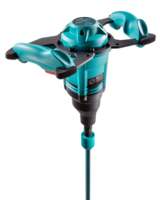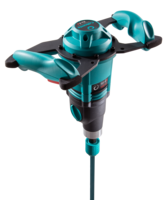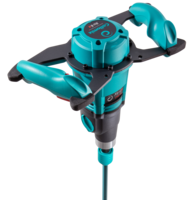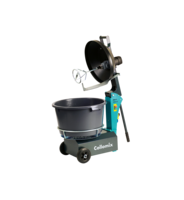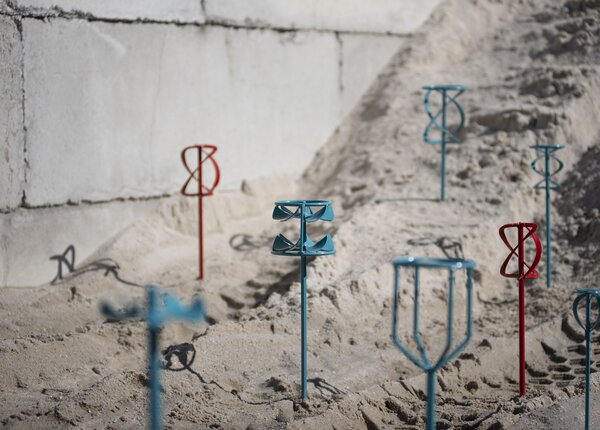
The Benefits of Mixing Properly
How to Mix Plasters Containing Gypsum
Also known as plaster of Paris, gypsum is a common component in drywall plaster. Combined with water and other materials, depending on what’s required for the project, gypsum wall plaster sets up over time, forming a hard surface that lasts a long time. However, lack of care in the measurement of the ingredients and the mixing process can lead to poor results, patience and accuracy in mixing and measuring will create plaster that will last for decades.
Does the mixing process for gypsum plastering impact the end result? Absolutely! The mixing process can make a big difference between success and failure. To get the best results, you need a mixing machine that will give you plaster that is, free of lumps, bumps, and other issues. Unlike concrete and mortar, there's only a little sand, making lump breakup very important in selecting the right paddles for the mixing process.
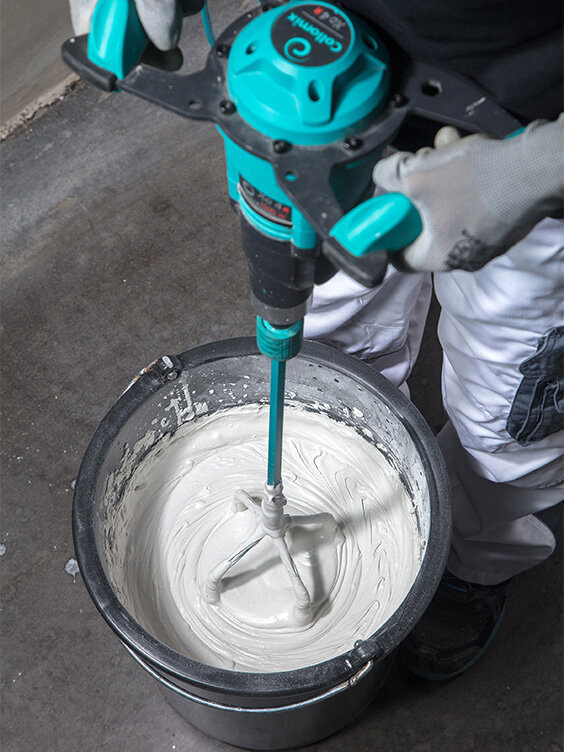
Ingredients in Gypsum-Based Plaster
It's important to understand how the ingredients in plaster work together to ensure that the plaster is mixed properly.
Gypsum. Much like the primary ingredient in concrete,mortar, and cement, gypsum is used to hold the mix together. A calcium-based chemical substance, gypsum is heated to a little over 300 degrees, at which point it adheres as a binding agent when combined with water and fine sand. It's a fairly fine substance, about the consistency of flour, so it needs to be mixed using the right tools for the job.
Sand. The next ingredient is sand in only a small amount. This sand is fairly fine to decrease its impact on the mix. Sand is used to help mix the gypsum and the water, but it lacks the components needed to break up the lumps.. Using the right paddles for the job makes the difference between a good mix and a poor one.
Water. Your gypsum plaster may require different percentages of water based on your end use. As the water is mixed in with the gypsum, it activates the chemicals in it, specifically the calcium, which then begin to harden and create a strong surface. However, without the right tools, measuring the amount of water you need can be a difficult, time-consuming process and compromise the quality of the mix if not measured accurately.
HOW TO MIX GYPSUM PLASTER PROPERLY
Choose the right power source. Mixing gypsum plaster effectively requires using a strong power source that can move your mixing paddles effectively and efficiently. The best option for most situations is a paddle mixer, a specially-designed tool that has an ergonomically-positioned and -designed hand-held motor. This motor has a spindle and attachment point that can hold different paddles that can be switched out on an as-needed basis. The different paddles can handle different consistencies and types of flow, creating different options for force, speeds, and air volume mixed into the material.
The hand-held paddle mixer provides strong levels of control through the mixing process. Rather than using more energy than needed, you can visually see the materials being incorporated into the mix, allowing you to adapt to the changing conditions. Though there would be the option to use an automatic mixer or drum-style mixer, this type of mixing doesn't always provide you with the sort of smooth, consistent results you may expect, as these are often designed for mixing concrete. Paddle mixers are able to handle from 10 to 24 gallons of material at a time, making them strong powerhouses on the work site.
Although it can be tempting to use a high-powered drill to mix your gypsum plaster, drills have the wrong set of specifications and designs for mixing. Drills have low torque and high speed, while paddle mixers have high torque and low speed, which is ideal for mixing. This combination of factors in a drill causes it to burn out quickly because mixing puts more strain on the motor for a longer period of time. In addition, paddle mixers have larger motors designed for the task at hand. However, if you do need to mix large quantities, the Collomatic AOX-S can be customized to your specific needs.This automatic machine cuts back on labor and time.
Choose your paddle. Once you've selected your paddle mixer that has high torque, will work with the amount of material you need to have mixed, and has an ergonomic fit for your crew– you have your choice of a variety of paddles you can use. However, you'll want to carefully consider your choice to get the perfect mixture for your needs. For mixing gypsum plaster, there are two paddles that we highly recommend to ensure that you'll get great results every time.
The first choice is the MKN paddle, which is a good choice when you need to mix a large quantity of plaster at one time. This paddle has three mixing blades that are designed to push the softer material down with force. This process ensures that you'll see rapid wetting while preventing and counteracting lump formation. Gypsum plasters are very soft and creamy in consistency, so the MKN is a valued mixing tool for many experts. Your second option is to go with the KR paddle, which is a good option for using a hand-mixer or a mixer-drill to mix smaller batches of gypsum plaster. This paddle applies appropriate energy and shear forces to the mix so that you can get a lump-free, homogeneous mixture. This type of paddle is a great option for these smaller batches, providing you with a powerful tool for patch jobs and similar projects.
Choose your accessories. The next step is to choose the appropriate bucket for your needs as a good match to your paddle mixer and your paddle. As a basic rule of thumb, your bucket should always be approximately 33% larger in size than your maximum fill level. This is so that the splatter that can take place during the mixing process is contained.
Mixing water into your gypsum can be a complex process that requires precision, which is good use for an AQiX, an automatic water dosing device that precisely measures the water used in your mixes. Similarly, because of the fine powder of the gypsum, a dust extractor can be a powerful tool to prevent issues with health in your workers. Easily attaching to the bucket, it vacuums up dust before it can escape the bucket.
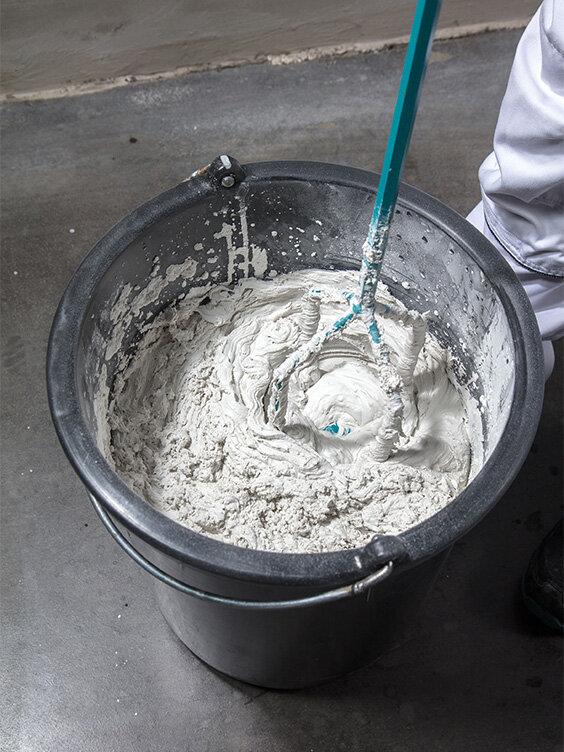
Process of Mixing Gypsum Plaster
Whether you're making your own mix or are using a pre-bagged mix, using the correct ratio is important, especially when adding water.
First: Start by adding about two-thirds of the water to the bucket, then the gypsum plaster and any additives you want to add. After these items are all in your bucket, it's safe to start the paddle mixer so that you can blend the materials effectively.
Second: After you've started mixing, the remaining water can be added. Measure the water precisely without trying to "eyeball" the measurement. The best possible results can only occur when you get the ratios of material perfect.
Third: Continue to mix the materials with your chosen mixer and paddle until you get everything thoroughly incorporated. When you use the right paddle mixer and paddles, the process is almost effortless, not requiring brute force or strength. All that's needed is holding the mixer upright in the bucket and keeping the mixer steady so that the paddles can work. This also gives you the most consistent mix through perfect speed, power, force, and ratios.
Finally: The perfect mix of gypsum plaster will be neither too crumbly or watery. It should have a creamy, smooth texture that spreads easily into gaps while retaining its shape when placed on walls. Do not add more water once the mixing process has been completed.
